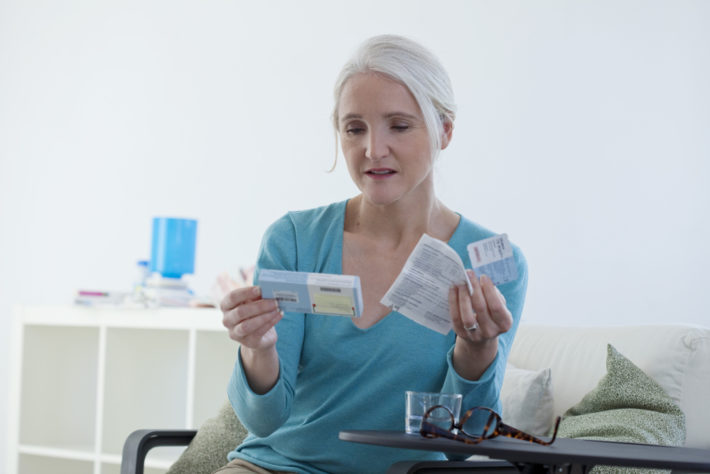
Get the pros and cons of each delivery system
Swallowing an estrogen-only or estrogen-progestogen tablet or pill is the most popular delivery system. Millions of women have taken a daily birth control pill, so taking HT by mouth seems familiar to them. Most women take them at bedtime. The estrogen pill Premarin has been studied more extensively than any other form of estrogen but the bioidentical estrogen pill estradiol is also widely used. HT tablets are absorbed from the intestines and pass through the liver and the enterohepatic circulation. Orally administered estrogen reduces LDL (bad) cholesterol levels and increases HDL (good) cholesterol levels in postmenopausal women with normal or elevated baseline lipid levels. Oral estrogen, particularly higher levels, is associated with an increased risk of blood clots.On the other hand, with a lower dose of conjugated estrogen of 0.45 milligrams or less and the estrogen estradiol, it’s less likely that blood clots will develop. Dosages are typically once daily, although estradiol tablets don’t last as long in the bloodstream and may require twice-daily dosages. For symptoms of menopause, such as hot flashes, relief may come as soon as a few days or may take up to 4 to 6 weeks.
2. Topical creams, gels, and sprays
These products contain estrogen, typically the bioidentical estrogen estradiol, that is applied directly to the skin, which is called transdermal. Since you’re not swallowing the pill, the estrogen bypasses the liver, and that lessens the risks of stroke and blood clots.
On the other hand, some women have skin that can react negatively to estrogen or doesn’t absorb creams, gels, or sprays well. These must be applied specifically as directed. First, thoroughly wash your hands before and after applying estrogen, so it doesn’t come in contact with your partner or other people, especially children, or pets that may lick the skin area covered with estrogen. If someone else does come into direct contact with the product within the first 2 hours after applying it, have them immediately wash the specific area with soap and water. Covering your skin with clothing for a few hours where the product was applied decreases any potential risk of the cream, gel, or spray coming into contact with another partner, child, or pet. There are a number of reports of dogs licking the area where estrogen was applied and then showing behavioral changes or mimicking being in heat.
While the dosages are typically once or twice daily, the amount spread or sprayed on the skin may vary slightly with each application. Compounding pharmacies prepare hormone creams by mixing a known amount of hormones into a container of cream or gel and then stirring it up. Sometimes the actual dosage you receive of a cream or gel may vary because of the mixing of the hormone. As with oral estrogen, relief may come as soon as a few days or may take up to 4 to 6 weeks. Warning: Applying sunscreen before applying a patch, cream, or gel may increase your exposure to estrogen. Applying sunscreen before applying a spray does not affect estrogen exposure.
3. Adhesive patches
Adhesive patches are another form of transdermal estrogen. They vary from the size of a dime to the size of a silver dollar. Wash and dry your hands before touching the patch. Most contain bioidentical estradiol. Clean the area where the patch will be applied using a cotton ball and alcohol. The adhesive side sticks to the skin and transfers the hormone to the body. Place the patch on one side of the lower abdomen or on the upper back near the shoulder. Patches are changed and discarded and a new one applied to the opposite side once or twice weekly depending on which patch you use. If the patch begins to peel off before it’s time to change it, cover it with a bandage or medical tape. Or take it off and heat the patch with a hair dryer set to low to help it stick back on. Patch dosages are very regulated and carry the same amount of HT as every other patch, so there is no guessing whether you’re getting the right dosage.
While patches carry lower risk of blood clots than oral estrogen, some women have an allergy to the adhesive or skin that doesn’t allow for optimum penetration and absorption. Patches that have a reservoir of estradiol such as Estraderm are more likely to be irritating to the skin. Newer patches such as Vivelle or others, which use a matrix delivery system, are unlikely to cause skin sensitivity. Some women lead active lives, which may cause the patch to come off. Patches protect against the same things that other forms of estrogen do, and relief comes within days or up to 4 to 6 weeks, as with other forms of estrogen.
4. Vaginal creams, suppositories, and tablets
Vaginal creams and suppositories with estrogen alone or an estrogen-progesterone (typically one or the other and not both, though compounded creams can contain both) combination are usually inserted with a plastic applicator. The directions that come with them are easy to follow. Vaginally applied estrogen tends to remain mostly in the vagina, but small amounts do enter the bloodstream.
Vagifem estrogen tablets, which are inserted into the vagina, allow only modest amounts of estrogen to enter the bloodstream, but the dosage is quite low, so some women may not get adequate improvement of their vaginal dryness. Many women who are prescribed Vagifem on their own will double the dosage, which will slightly increase the amount that enters the bloodstream. That level will still be low, but oncologists who are asking their breast cancer patients not to take any estrogen may encourage not doing this. If you are in that situation, discuss it with your doctor or even get a second opinion; quality of life is also very important. Recently, the American College of Obstetricians and Gynecologists (ACOG) released an Opinion Report stating that if non estrogen treatments of vaginal dryness failed to correct the problem, discuss it with your oncologist and ask your gynecologist for local vaginal estrogen, even if you have estrogen-receptor positive breast cancer. The ACOG publication found no evidence of an increase in either breast cancer recurrence or death following the use of vaginal estrogen.
5. Pellets
Estrogen is also available as bioidentical pellets. They have been around a long time but are not as widely used as some of the other forms and are not FDA approved. Years ago, I went to London to visit the queen’s gynecologist at that time, J. W. W. Studd, on Harley Street, to learn how to insert them; they were quite popular there. The line formed to receive them that Saturday morning went out the waiting room, down the steps, and around the corner. It comes in different dosages and is implanted under the skin with a small incision and an instrument about the width of a pencil. The small incision is closed with a stitch or an adhesive, and the stitch is removed in a day or two. The procedure is done with local anesthesia, and usually the pellets last for 4 to 6 months. I prefer FDA-approved delivery systems as the blood levels are not consistent following pellets and levels may stay elevated for many months.
6. Vaginal ring
Vaginal rings deliver an estrogen dosage that enters the bloodstream. Though the dosage may be too small to guarantee protection against osteoporosis, it may help other symptoms, such as hot flashes and night sweats. To insert a vaginal ring, thoroughly wash and dry your hands before and after. It’s like putting in a diaphragm. If you’ve never done that, ask your health-care provider to show you how to insert it. Choose a position that’s comfortable for you, such as lying down, squatting, or standing with one leg propped up on a chair. Hold the ring between your thumb and index finger and press the opposite sides together. Gently push the folded ring as deeply as possible into the upper one-third of the vagina. If you have any discomfort, the ring is probably not inserted far enough into your vagina. Use your finger to gently push the ring farther into your vagina.
Your cervix will block the ring from going past the top of the vagina. If you’ve had a hysterectomy, just insert it gently in as far as you can. Either way, you can only insert it as far as the end of the vagina. If you feel the ring move during a bowel movement or when coughing, wash your hands and use a finger to push it back into place. If the ring is removed or falls out of the vagina for any reason, just rinse the ring with lukewarm water and reinsert it. A ring is usually left in place for 90 days, then replaced with a new one, so be sure to follow the dosing schedule carefully. Vaginal symptoms often improve within days, although it may take several weeks.
If you are interested to know how much your menopause symptoms are affecting your life, health or happiness, take this 2-minute MenopauseQuiz.com. You’ll get immediate feedback to your inbox and tips to help you.





